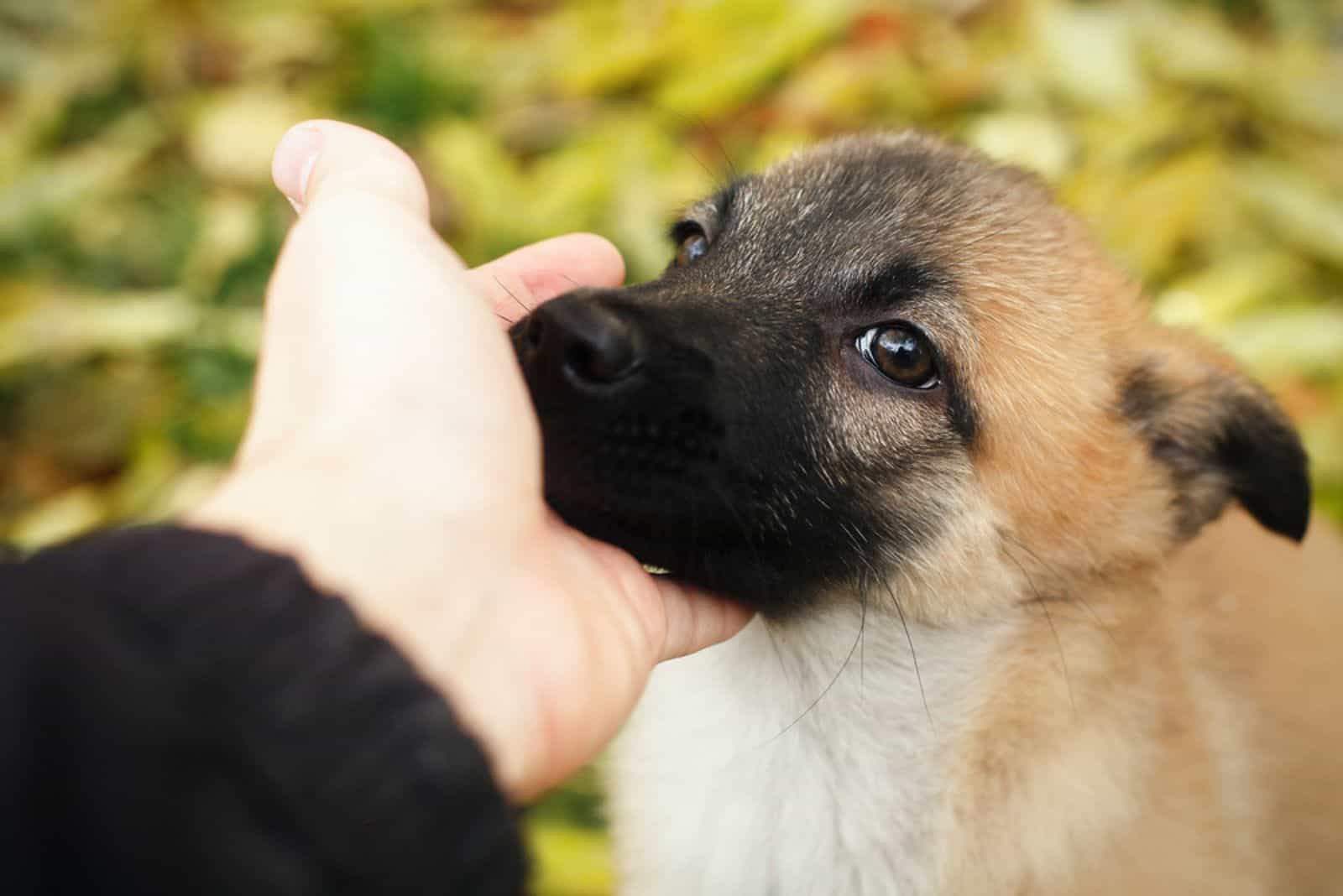Dogs have an incredible ability to pick up on energy, and they can often sense when something is amiss. If you’re feeling down or stressed, your furry companion may become agitated or anxious.
In fact, dogs are known to be intuitive caregivers and can even sense when their humans are feeling down, unwell or in pain. That’s why we have service dogs, right?
So, can dogs sense negative energy? The short answer is yes!
Let’s find out all about canines and their ability to sniff out bad vibes!
Science Says Yes

How does a dog’s brain process negative energy? Well, it has a lot to do with their olfactory system a.k.a the nose!
We all know that dogs have an extraordinary sense of smell, right? But, it goes beyond just detecting scents.
According to a study by D’Aniello, dogs can actually recognize human emotions, like fear or happiness, through their sense of smell (1).
The study also found that when dogs were exposed to human odorant stress signals, their reactions were longer compared to when they were exposed to happiness signals.
This suggests that dogs are even more attuned to detecting stress and negative emotions by using their nose.
According to yet another captivating study, researchers found that when it comes to the influence of owner personality traits, solitary hunting breeds were more susceptible compared to ancient breeds.
The study also found that there were no signs of long-term stress synchronization between owners and their dogs.
However, the study did find that herding dogs and their owners showed long-term stress contagion (2).
Could it be due to the breed selection for close human cooperation? It could be pawssible!
Dogs Can Detect Negative Energy Through Body Odor

Their exceptional sense of smell allows them to pick up on subtle changes in human body odor and pheromones, which can indicate stress, fear, or other negative emotions. Yes, dogs can sniff out more than just toys and treats!
In one experiment, samples of breath and sweat were collected from stressed-out participants who had just completed a task that made their hearts race and blood pressure spike.
These samples were then presented to trained dogs, who were tasked with identifying the stressed person’s odor among other samples.
And guess what? The dogs aced the test!
They were able to detect the changes in Volatile Organic Compounds emitted by humans in response to stress, proving that our canine companions have an uncanny ability to sniff out our emotional state.
This finding sheds light on the fascinating human-dog relationship and could even have applications in training anxiety and PTSD service dogs, who traditionally rely on visual cues (5).
In another study, Labradors and Golden Retrievers were exposed to different human body odors that represented fear, happiness, and neutral emotions.
When the dogs sniffed fear, they exhibited more signs of stress and had higher heart rates.
But when they caught a whiff of happiness, they were more interested in the strangers associated with the happy scent (6). Pretty cool, don’t you agree?
Dogs Can Detect Negative Energy Human Voice And Facial Expressions

Dogs are like expert body language readers, mastering the art of understanding human communication beyond just spoken words.
They can perceive changes in the tone of human voices, as well as read body language and facial expressions, which can convey negative emotions.
In fact, a study shows that less than 10% of what we convey is through verbal language, while 90% is through non-verbal cues like posture and facial expressions.
Researchers have discovered that for dogs, bodily emotional expressions are like a survival toolkit – a primary source of information that helps them navigate their environment.
Unlike humans, who may focus on other cues, dogs rely heavily on emotion cues to thrive in the world, just like all mammals do (3).
It’s fascinating how these furry friends have evolved to prioritize and interpret emotions for their fitness and survival!
Recent research also reveals that just like humans, dogs experience emotional contagion when they hear an infant cry.
This means they can pick up on the negative energy and respond with heightened alertness and increased cortisol levels, showing a primitive form of empathy (4).
Dogs also have an innate ability to sense emotions and energy through their intuition, or as many paw owners refer to as the sixth sense.
Telltale Signs Your Dog Picks Up On Negative Energy

It’s believed that dogs can sense negative energy by tuning into your emotions. So if you’re feeling overwhelmed, anxious, or upset, your dog may mirror those feelings.
Some common signs that dogs show when they detect negative energy include:
- Restlessness
- Avoidance
- Changes in body language
- Agitation or aggression
- Changes in appetite or grooming habits
- Changes in energy levels
- Seeking comfort
- Behaving overly affectionate
Dogs may show signs of sensing negative energy in situations such as during arguments between humans, meeting new people or animals, unfamiliar or stressful environments, when their owner is upset, exposed to negative people or animals, or during thunderstorms or natural disasters.
It’s important to pay attention to your dog’s body language and behavior for cues that they may be reacting to negative energy.
Remember – your pup is always there, keeping a watchful eye on your emotions, so be sure to give them the love and care they deserve in return.
Final Thoughts

Our furry pals are more than just pets – they’re incredible emotional detectives!
Dogs have an uncanny ability to sense negative energy in their environment, thanks to their keen senses and impeccable observation of non-verbal cues.
Whether it’s picking up on changes in body language, vocal tone, or even detecting stress-related body odors, dogs are intuitive companions who can offer comfort and support when we need it the most.
So, the next time you’re feeling a little blue, don’t be surprised if your furry friend is there to lend a paw and brighten your day with his remarkable ability to sense and respond to negative energy!
References:
1. D’Aniello B., Fierro B., Scandurra A., Pinelli C., Aria M., Semin G.R. Sex differences in the behavioral responses of dogs exposed to human chemosignals of fear and happiness. Anim. Cogn. 2021;24:299–309. doi: 10.1007/s10071-021-01473-9.
2. Höglin, A., Van Poucke, E., Katajamaa, R. et al. Long-term stress in dogs is related to the human–dog relationship and personality traits. Sci Rep 11, 8612 (2021).
3. Correia-Caeiro C, Guo K, Mills D. Bodily emotional expressions are a primary source of information for dogs, but not for humans. Anim Cogn. 2021 Mar;24(2):267-279. doi: 10.1007/s10071-021-01471-x. Epub 2021 Jan 28. PMID: 33507407; PMCID: PMC8035094.
4. Yong MH, Ruffman T. Emotional contagion: dogs and humans show a similar physiological response to human infant crying. Behav Processes. 2014 Oct;108:155-65. doi: 10.1016/j.beproc.2014.10.006. Epub 2014 Nov 4. PMID: 25452080.
5. PLOS. “Dogs can smell when we’re stressed, study suggests: Dogs could differentiate breath and sweat samples from people before and after a stress-inducing task.” ScienceDaily. ScienceDaily, 29 September 2022.
6. D’Aniello, B., Semin, G.R., Alterisio, A. et al. Interspecies transmission of emotional information via chemosignals: from humans to dogs (Canis lupus familiaris). Anim Cogn 21, 67–78 (2018).















